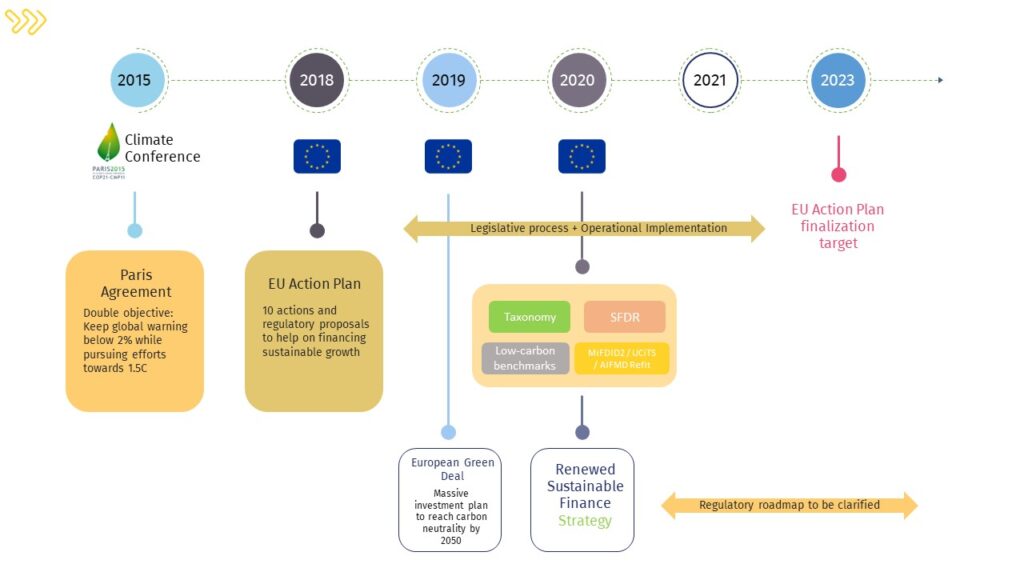
- March 30, 2021
- EU Taxonomy, European Commision, Financial Market, Green Regulation, Green Taxonomy, Greenwashing
The European Taxonomy
Here we describe the main elements of a green taxonomy, a set of criteria that define
activities consistent with the achievement of carbon neutrality objectives, this is the first
attempt in Europe to classify issuer sectors at a fairly fine level.
In this article, we trace its origins and answer several questions. What is the European
classification? Who wrote the taxonomy? Why file? Who will use the taxonomy? When
will it come into force? Does taxonomy define norms for social aspects?
What is the European taxonomy?
The European taxonomy is a list of activities and criteria to qualify a company’s sustainable activities
in relation to the fight and adaptation to climate change.
Who wrote the Taxonomy?
In 2018 the European Commission created a group of experts from companies, civil society finance,
etc. to work on the taxonomy and its criteria. These experts produced a final report that was released in March 2020. This report served as the basis for the drafting of the taxonomy itself, which was voted on and approved by the European Parliament and European governments in July 2020.
Why a taxonomy?
The European Union has set ambitious environmental targets, in particular the goal of becoming netzero by six 2050. The taxonomy aims to accompany companies that need to transform to develop new products of our way of operating, but the taxonomy is not only companies also hoped investors to know to those who go through their allocation decisions of the type of project and the type of products developed by these companies.
Who’s going to use the taxonomy?
The taxonomy is aimed primarily at companies for whom it defines the eligibility criteria to qualify sustainable activities within the framework of its environmental objectives of the European Union but it is also of course aimed at investors have to communicate on the part of their investments that meets the criteria of the taxonomy but that will also be able to create new products aligned with the taxonomy.
Finally, the taxonomy is aimed at the Government and the European Central Bank and will allow the Government to better direct their investments and the subsidies they allocate in line with the European Union’s environmental objectives. The European Central Bank could very well launch a bond and asset buyback program that would incorporate environmental aspects from the taxonomy.
When does it come into effect?
A first part of the taxonomy will come into effect in 2022. This part is about climate change. the rest of the taxonomy will cover other aspects related to the European Union’s environmental objectives, namely the circular economy, waste reduction, protection of biodiversity and water resources.
Moreover, by 2023, an ecolabel applicable to investment products will also be launched inspired by the taxonomy and specified the criteria that its products and investments should meet to be eligible.
Example
- Let’s take a few examples of car production when it has the taxonomy defined at a ceiling in terms of CO2 emissions/ km above which the car cannot be considered compatible with the taxonomy. 50g/km is very strict which means that today no car with internal combustion diesel engine or gasoline could consider as compatible except plug-in hybrid cars.
- Another example is the production of cement or steel or aluminum here the taxonomy recognizes that these sectors contribute to allow for example the installation of renewable energies that is it takes cement or steel to install a wind turbine and therefore consider these activities compatible, but if they meet certain criteria, such as a maximum level of CO2 emissions per ton of products.
Does the taxonomy define criteria on social aspects?
Social aspects are already included in the taxonomy as a company to be eligible to meet certain minimum standards related to human rights and working conditions. However, among the objectives defined by the taxonomy the social aspects are not to present its objectives are purely environmental so to have a social taxonomy it would be necessary that the European Union define social objectives which could subsequently be translated into a taxonomy.





Leave a Comment